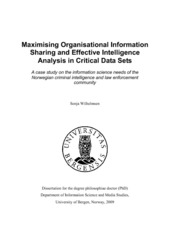| dc.description.abstract | Organisational information sharing has become more and more important as the amount ofinformation grows. In order to accomplish the most effective and efficient sharing ofinformation, analysis of the information needs and the organisation needs are vital. Thisdissertation focuses on the information needs sourced through the critical data sets of lawenforcement organisations; specifically the Norwegian criminal intelligence and lawenforcement community represented by the National Criminal Investigation Service(Kriminalpolitisentralen (Kripos)). Information sharing is particularly important in thesecommunities due to consequences for alleged perpetrators, victims and witnesses.The theoretical framework starts with a brief investigation into the classical, mechanistic, andthe systems worldviews before investigating different aspects of organisations; publicadministration; criminal justice organisations; an organisation’s internal structure andenvironment; and organisational culture. Today most information systems consist of bothhumans and computers, hence; an investigation into the concepts of data, information,knowledge, and information systems has been performed; review of different definitions;review of what a computerised information system is as opposed to knowledge systems orexpert systems; examination of information systems in an organisational context; andinvestigation of information systems development particularly requirements gathering andanalysis. The last subject in the theoretical investigation relates to investigation and analysisof criminal actions; define and distinguish the terms investigation and intelligence; examinehow the concepts of data, information, and knowledge are used in criminal investigation;define and distinguish the different forms of law enforcement analysis; and last investigateeyewitness testimonies which, despite the many advances in forensic science, of many stillconsidered the most important information source in criminal investigation.The empirical investigation at Kripos was performed using several different research methodsaimed at qualitative aspects of the data followed by qualitative analysis. The theoretical viewsadopted in the research and the different data gathering methods allowed the researcher toexplore information sharing throughout the organisation from both written and oral sources,and by doing so being able to; (1) identify possible communication break down points andspecify an ideal communication pattern between different tribes (consisting of experts in thedifferent fields needed in a criminal investigation); (2) develop an extended intelligence process which was mirrored in (3) the specification of the borders for the computerisedinformation system, and (4) the developed conceptual data model for a computerisedinformation system; (5) specify a log function for the computerised information system. | en_US |
